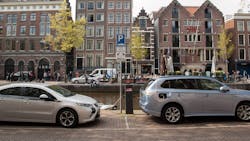U.S. Utilities Expanding Managed Charging Programs for EVs, Finds Study
The sixth edition of Northeast Group's new study shows U.S. utilities are increasingly viewing electric vehicles (EVs) as a critical building block of their distributed energy resource (DER) plans, helping to smooth electricity demand while lowering costs for customers. For EV owners, utilities have been expanding their managed charging program offerings that help shift EV power demand to lower cost off-peak hours. Over one-third of the largest 100 utilities in the United States now offer these programs, according to the study.
"Utilities have long offered EV customers time-of-use (TOU) rates, but the recent shift to active managed charging has really opened the door to using EVs for demand response and subsequently as DERs," said Ben Gardner, president of Northeast Group. "Utilities can now directly control the charging of a customer's EV to the time when prices and demand are lowest, saving customers money while smoothing load curves."
In the mid-2010s, Northeast Group found that 18 of the 100 largest U.S. utilities offered EV tariffs, but managed charging had yet to take off. But now, in 2020, 21 of the top 100 utilities offer EV tariffs while 14 utilities offer active managed charging such as direct load control via the EV charger, automobile telematics, or both. Many of these are the largest utilities in the country — such as Pacific Gas and Electric Co. (PG&E) and Southern California Edison (SCE) in California and Duke Energy Carolinas — reaching a large swath of EV owners in the United States.
Honda Fit owners in SCE service territory are eligible for bonuses for participating in demand response events coordinated through eMotorWerks' JuiceNet software platform and relayed via Honda's onboard vehicle telematics. eMotorWerks coordinates the demand response events based on the California Independent System Operator (CAISO) signals. The HondaLink EV App considers real-time electricity grid conditions to reduce costs to the customer, while also considering customers' charging preferences.
Yet, participation rates remain low despite the savings. Northeast Group found that on average customers could save 37% more with EV managed charging or TOU rates than with standard electricity tariffs. For EVs to truly become an important DER, utilities will need to work with regulators and automobile and charging equipment vendors to demonstrate these benefits and incentivize these programs. One key element to boosting participation rates could be making 'opt out' the standard rather than 'opt in' for utility customers.
Utilities and regulators are already providing some good policy incentives and an expansion of these incentives across more states and service territories may help EV managed charging to grow. For example, some utilities offer their customers cash rebates to pay for EV chargers at home. These programs should be expanded. Also, customers can receive financial incentives if they allow the utility to control the charging of their EV during critical peak periods in a type of demand response program that helps to shift load to off-peak periods. By automatically enrolling customers in these types of programs (which they could still opt out of) versus waiting for them to opt in, utilities and regulators can greatly boost participation rates and the effectiveness of these programs.
EV managed charging programs offered by utilities have sought to keep pace with the growth of EVs on the roads. By its nature, the utility sector is heavily regulated so utility programs can take time to roll out but overall, utilities have done a pretty good job in offering their customers new and innovative options for recharging their EVs while at the same time acknowledging the potential of EVs as a DER.
Many utilities have already begun work in promoting managed charging programs, both on their own and with partners. Existing utility partners include automakers such as BMW, GM, Honda, and Nissan, charger manufacturers such as ChargePoint, Clipper Creek, and Greenlots (Shell), and grid vendors such as Itron and Siemens. Expansion of these programs — along with continued growth in EV sales —will ensure that EVs make a significant contribution to the growth of DERs in the United States.
For more information on EV Managed Charging: US Outlook & Benchmark of Top 100 Utilities, visit here.
